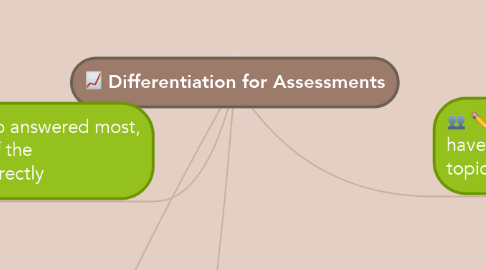
1. Assessment Used to Test Progress
1.1. Teacher could give students some smaller quizzes about the elements of narrative to assess student understanding of the academic language teacher can also have students do frequent writing activities to assess students abilities to utilize skills and concepts of narrative writing in a practical way.
2. Group 1: 5 students who answered most, including the most difficult, of the pre-assessment questions correctly
2.1. Innovative Strategy:
2.1.1. These students will need strategies that can access students critical thinking skills and engage them by diving deeper into the the content. For a unit on narrative writing, accessing critical thinking skills is very important. Students who scored well on the pre-assessment could be given more opportunities to peer review each others narratives. Peer review allows students to reinforce their understanding of the narrative elements while also asking students to think critically about how those elements function in a piece of writing and how they could be revised.
2.2. Assessment Used to Track Progress:
2.2.1. Teacher could review peer review revision suggestions to assess student understanding. Teacher could also have students use the discussion section of Kahoot to discuss elements of narrative writing. Teacher can use students discussion to gauge their understanding of the content so far and inform the teacher what concepts may need reteaching.
3. Group 2: 12 students who have some knowledge about the topic as shown in their score, but need to develop higher order thinking skills
3.1. Innovative Strategy
3.1.1. Students who have some knowledge of the concepts need a different form of differentiation. Students in this range often need reinforcement of the knowledge they already have while also expanding on that knowledge. One method of differentiation for this group could be having them frequently read and analyze sample narratives to reinforce their understanding of the elements. Also students in this group could also benefit from graphic organizers to help them organize their thoughts before writing.
4. Group 3: 5 students who appear to have limited knowledge about the topic
4.1. Innovative Strategy:
4.1.1. Students in this group may need substantial differentiation as the unit passes. Students in this group may need the aid of graphic organizers or sentence stems when writing. Students may also need word banks to help them with academic language. Students may also need to work in small groups one on one with the teacher to receive additional instruction or the reteaching of skills.
4.2. Assessment Used to Track Progress:
4.2.1. Teacher will need to closely monitor this group to ensure they grow accordingly. Teacher can assess student growth through the small group/one on one work. Teacher can also assess student growth through short writing samples or quizzes. Teacher could also use short formative assessments (i.e. exit tickets, response cards, etc.) to quickly learn how much students have grown in each lesson.
